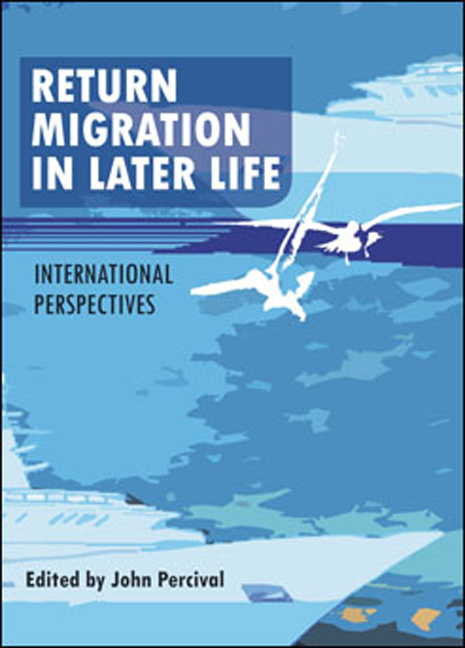Book contents
- Frontmatter
- Contents
- List of tables and figures
- Notes on contributors
- Acknowledgements
- one Charting the waters: return migration in later life
- two Older immigrants leaving Sweden
- three Place and residence attachments in Canada’s older population
- four Ageing immigrants and the question of return: new answers to an old dilemma?
- five Caribbean return migration in later life: family issues and transnational experiences as influential pre-retirement factors
- six ‘We belong to the land’: British immigrants in Australia contemplating or realising their return ‘home’ in later life
- seven Diasporic returns to the city: Anglo-Indian and Jewish visits to Calcutta in later life
- eight Returning to ‘roots’: Estonian-Australian child migrants visiting the homeland
- nine Ageing in the ancestral homeland: ethno-biographical reflections on return migration in later life
- ten ‘The past is a foreign country’: vulnerability to mental illness among return migrants
- eleven The blues of the ageing retornados: narratives on the return to Chile
- twelve Concluding reflections
- Endnotes
- Index
two - Older immigrants leaving Sweden
Published online by Cambridge University Press: 01 February 2022
- Frontmatter
- Contents
- List of tables and figures
- Notes on contributors
- Acknowledgements
- one Charting the waters: return migration in later life
- two Older immigrants leaving Sweden
- three Place and residence attachments in Canada’s older population
- four Ageing immigrants and the question of return: new answers to an old dilemma?
- five Caribbean return migration in later life: family issues and transnational experiences as influential pre-retirement factors
- six ‘We belong to the land’: British immigrants in Australia contemplating or realising their return ‘home’ in later life
- seven Diasporic returns to the city: Anglo-Indian and Jewish visits to Calcutta in later life
- eight Returning to ‘roots’: Estonian-Australian child migrants visiting the homeland
- nine Ageing in the ancestral homeland: ethno-biographical reflections on return migration in later life
- ten ‘The past is a foreign country’: vulnerability to mental illness among return migrants
- eleven The blues of the ageing retornados: narratives on the return to Chile
- twelve Concluding reflections
- Endnotes
- Index
Summary
Introduction
Most research on temporary migration deals with labour migration by young people and large-scale quantitative studies of international return migration in old age are few. This study is the first to analyse patterns of old-age return migration in the complete immigrant population in a single country over a longer time period. The study analyses return migration from Sweden among immigrants 55 years or older during the period 1990–2007, a period of globalisation and increasing international mobility (United Nations, 2009). The study addresses the question of labour market attachment and return migration in later life.
Earlier studies have shown that return migration in working age often displays a positive selection in terms of education and income history in the host country, in that return migrants on average display higher levels of education and income compared with migrants who stay in the country of destination, leading to the conclusion that return migration is generally not the result of weak economic integration (Klinthäll, 2003; Nekby, 2006; Klinthäll, 2007). Regarding migrants of older age, the processes of migration and integration may however look different. Entry or re-entry into the labour market, as well as social integration and adaptation in the host country, may be more complicated for older migrants, depending on time since immigration and age at immigration. Hence, we may expect different types of return migration processes among older immigrants; older return migrants may be positively selected due to strategies of temporary migration that involve target-saving behaviour, resulting in relatively higher incomes among return migrants. ‘Return of retirement’ (Cerase, 1970) would thus be the result of an accomplished career in the host country.
However, retirement-return migration could also be the consequence of losing contact with working life in the host country. Older immigrants who have a weak position in the labour market and who exit employment before retirement may not consider a continued career as realistic. With few years left to retirement, re-entry into the labour market may not seem feasible and return migration appears as an option. Hence, we may also expect an increasing propensity for return migration in connection with exits from the labour market other than age retirement, such as unemployment or early retirement due to sickness or lay-offs. Regarding return migration in old age, we may therefore expect polarised patterns of return migration; positive selection due to target-saving behaviour and negative selection due to weak labour market integration.
- Type
- Chapter
- Information
- Return Migration in Later LifeInternational Perspectives, pp. 21 - 42Publisher: Bristol University PressPrint publication year: 2013



